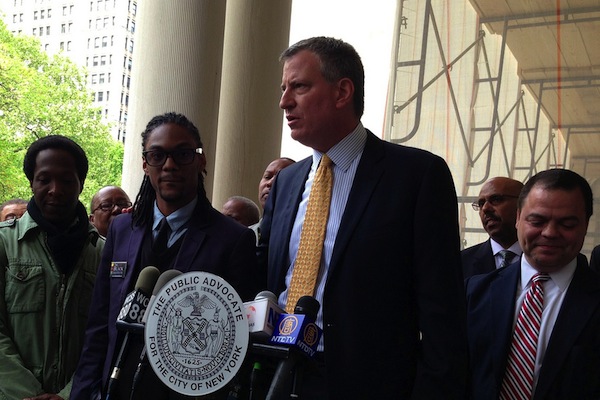
Photo by: Public Advocate Bill de Blasio
De Blasio, seen here at an earlier event, has long called for an income-tax surcharge on wealthy New Yorkers to pay for increased early childhood education.
For as long as anyone can remember, there’ve been two ways to think about the problem of the Have Nots. One focuses exclusively on the Have-Nots. The other is to talk about the role played by the Haves.
Over the past two days, two Democratic mayoral candidates trying to cut into the lead enjoyed by their better-recognized rivals have presented economic plans that pretty closely reflect those two schools of thought.
Former Comptroller Bill Thompson presented a plan that critiqued poverty. Public Advocate Bill de Blasio’s take was that the coexistence of poverty and extreme wealth as a problem in itself.
Thompson said yesterday that, “Growing, climbing, pervasive, insidious poverty has slammed the door of opportunity shut for millions of New Yorkers – and we have a responsibility to pry it open.” He added: “Poverty is not a problem for one community, for one borough, or for one group. Poverty is draining the opportunity away from New Yorkers in every borough, of every background – and, what’s worse, from people working almost around the clock, sometimes with two, three jobs.”
While Thompson did say that “Our focus has been on Manhattan’s elite corporate base instead of creating mid-range office jobs,” he didn’t emphasize the growing gap between rich and poor.
De Blasio did. He warned of the arrival of a “gilded city where the privileged few prosper and millions upon millions of New Yorkers struggle just to keep their heads above water,” lambasting an economy of $125 million penthouses, new records for the Dow, and restaurants that offer $1,000 caviar pizza. It’s “the best of times,” he said, for the city’s 389,000 milionaires, while elsewhere “the struggle isn;t limited to pockets in our city. It’s all around us.”
And it’s partly Mayor Bloomberg’s fault, De Blasio, speaking at the New School on Thursday, said. “Through neglect and denial many of our city’s policies over the last 12 years have made that gap more severe,” he charged. While he praised some of the mayor’s economic development record, including his efforts to attract biotech to New York, de Blasio added: “If all we do as a city is to replace one elite economy with another, we will have failed.”
Despite the difference in their diagnoses, Thompson and De Blasio’s economic plans display significant overlap. Both want to make better use of the city university system to train people for mid-level jobs, increase access to affordable housing (Thompson emphasized a one-year freeze on hikes to stabilized rents, de Blasio his call for mandatory inclusionary zoning) and childcare, and strengthen the links between high-school students and career paths.
Thompson wants to reorient job training to focus on a smarter set of skills, while de Blasio called for an approach that “grows whole sectors” of new jobs, like green jobs. Thompson focused on improving access to healthcare and reducing child hunger, while de Blasio called for a crackdown on wage theft an expanded living wage, and requiring construction projects funded by the city to employ low-income New Yorkers.
But there were Robin Hood aspects to de Blasio’s plan. He wants to end corporate subsidies and direct that money to CUNY and the a revolving loan fund for small businesses and start-ups. And, as he has said before, he wants to impose an income-tax surcharge on wealthy people to pay for expanded early childhood education.
The full speeches have a lot more detail. Read Thompson’s here and de Blasio’s here.








